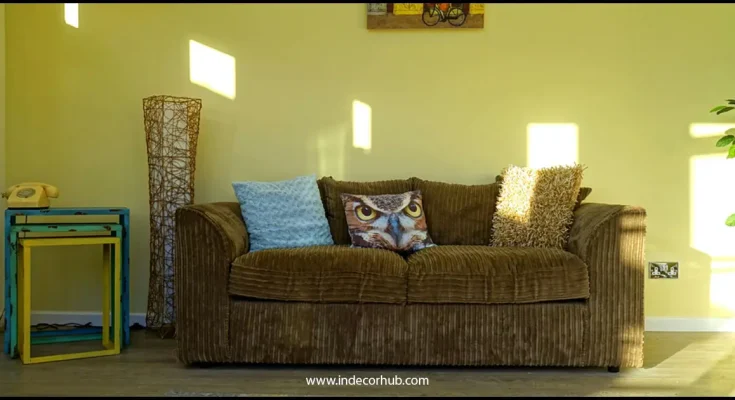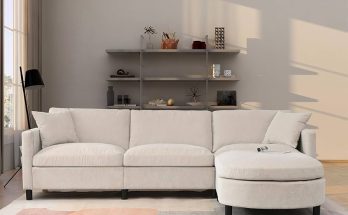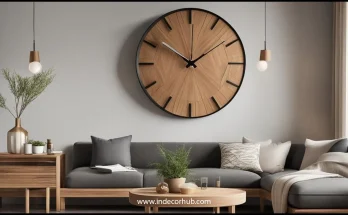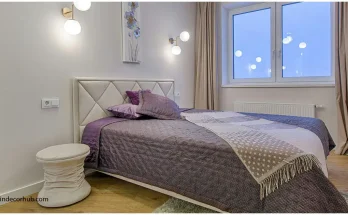A sofa is a single piece of furniture designed for sitting, while a sectional sofa consists of multiple interlocking pieces. Sectionals can be arranged in many different ways to provide flexibility.
Exploring the difference between a sofa and a sectional sofa is essential when considering living room furnishings. Sofas, often seen as the quintessential cornerstone of a cozy living space, are one solid structure, available in multiple styles and sizes. Those who are seeking individuality and flexibility in a sofa would find sectional sofas as their top choice.
Their unique design makes it possible for the owner to reposition the modules accordingly, thus making it possible to merge bigger spaces for a bigger number of guests. The versatile nature of the sectionals in themselves is extended to their functionality; the majority contain chaises, fold-out beds, and in some cases, built-in storage. Deciding between these two seating options hinges on the homeowner’s space, needs, and personal style preferences. This fundamental part of knowledge is a stepping stone that allows the shoppers to determine the suitability of an item to their needs in making the house cozy and homey.
Table of Contents
Introduction To Sofa Styles
Understanding the vast world of sofas can feel like a daunting task. Each of the styles of buildings offers features that satisfy particular requirements and preferences. From the streamlined simplicity of standard sofas to the customizable comfort of sectional sofas, the choice varies with lifestyle and decor. Let’s visit the main features and scenarios for these functional elements of our homes now.
Key Features Of Standard Sofas
A standard sofa typically has a straightforward, fixed design suitable for most spaces. Important features include:
- Fixed Seating Capacity: Usually accommodates up to three people.
- Consistent Style: A singular look that maintains uniformity.
- Variety of Designs: Options range from classic to modern.
- Space Efficiency: Ideal for smaller rooms or apartments.
Popularity And Usage Scenarios
Standard sofas enjoy widespread favor due to their versatility and ease of integration into various environments. They typically shine in:
- Living rooms with limited area.
- Offices are seeking professional elegance.
- Homes where a cozy nook is desired.
| Sofa Type | Best For |
| Standard Sofa | Compact spaces, simplicity lovers |
| Sectional Sofa | Large spaces, flexibility seekers |
Unpacking The Sectional Sofa
Time to dive into the cozy world of couches! Getting to know the sectional sofa is like opening a brand new comfort stage in home décor. We shall discuss what makes it different from the common sofa, the sectional sofa.
Defining The Sectional Sofa
A sectional sofa is more than just a place to sit. It is one modular furniture item that comes with many parts, which can be rearranged in different shapes. Usually found in L-shaped or U-shaped configurations, it adapts to room layouts and personal preferences. Imagine a puzzle where you’re the master, arranging pieces for the perfect fit in your space.
Variations Of Sectional Sofas
- Stationary Sectionals: These are fixed in layout and offer a classic, structured look.
- Reclining Sectionals: Equipped with reclining seats for added relaxation.
- Modular Sectionals: Feature separate pieces that can be rearranged to your heart’s content.
- Sleeper Sectionals: Include a pull-out bed for overnight guests.
- Chaises: Often incorporated into sectionals for an extended lounge area.
The purpose of each type of sectional sofa is to fit your necessity, whether it is just a seating arrangement or an option for a sleeper bed. Picking the right one could mean the difference between a rigid sitting area and a dynamic living space.
Design Philosophy
The ‘Design Philosophy’ of sofas and sectionals mirrors their roles in our homes. Imagine it as the real existence of home. This is the realm where comfort and creativity come together in one place, thus that’s where we either rest or interact.
Aesthetics And Architecture
Sofas offer a singular statement piece. Their design leans towards uniformity and cohesion. A singular philosophy drives their form. They bring a streamlined and classic silhouette. Sectionals, on the other hand, embrace a diversified framework. They are the puzzle pieces of furniture design. Sectionals adapt to a room’s unique architecture. They can meander around corners and split spaces into components as well. This makes them adaptable to facing all kinds of designs.
Customization And Flexibility
- Sectionals trump modularity. They consist of multiple pieces. You can arrange these pieces to fit your space and needs.
- Conventional sofas are more rigid in structure. They come in one piece. Yet, they anchor a room with timeless appeal.
- Custom features abound in sectionals. It may consist of chairs that can be customized, built-in desks, and more. Moreover, the sections are the part that makes sectional sofas able to be customized for individual conformity.
Whether for a small studio or a large den, the right design philosophy enhances the environment. It can strike the equilibrium between decoration and utility. Your choice between a sofa and a sectional will depend on your style, space needs, and living habits.
Size And Space Requirements
Size and Space Requirements often dictate the choice between a sofa and a sectional. Traditionally, sofas suit smaller living spaces or offer a sleek element in larger rooms. Sectionals provide ample seating and can easily fill up and complement vast spaces. Understanding your room’s dimensions is key to selecting the ideal piece.
Measuring For A Perfect Fit
Start with the dimensions of your living area. Measure the length, width, and height with a tape measure to obtain the dimensions of the area. Have you taken into account the doors, stairs, and corridors? Make sure your new furniture can get to the destination down the corridors. Smaller rooms might only accommodate a compact sofa, while larger areas may allow for a grand sectional.
- Measure the doorways: Ensure your furniture can pass through.
- Check the space: Mark the potential place for your sofa or sectional.
- Allocate walking room: Leave space for movement around the furniture.
| Furniture Type | Average Length | Average Width |
| Sofa | 72-96 inches | 30-40 inches |
| Sectional | 94-168 inches | 30-40 inches |
Space Planning For Living Areas
To harmonize the room, balance your furniture with the surrounding space. For smaller rooms, a sleek sofa leaves more floor area visible, creating an illusion of more space. Furnishing the sectional pieces can enable various sections within the same large area, like dividing dining from a lounge area.
- Functionality: Consider how you use the room daily.
- Layout: Arrange your room to maximize utility and comfort.
- Accent Pieces: Include coffee tables and rugs to complete the look.
Selecting the right furnishings requires a balance between room size, functionality, and your personal style. Whether choosing a sofa or sectional, it’s about making the best use of space, ensuring a cohesive and inviting living environment.
Seating Capacity And Arrangements
The heart of any living room is a place to sit and relax. Let’s explore how sofas and sectional sofas cater to your comfort needs.
Accommodating Guests
When it comes to hosting, the right seating arrangement is vital. A sofa traditionally seats two to three individuals. Sofas are great for smaller gatherings. On the flip side, sectional sofas invite more people to the mix. They are modular and can be configured to suit the number of guests. Look at the difference in capacity:
| Sofa | Sectional Sofa |
| Seats 2-3 | Seats 3-6+ |
Optimizing For Family Use
A cozy family movie night needs ample seating and comfortable arrangements. Regular sofas don’t usually have the flexibility to move around. But, sectional sofas change the game. They give families the flexibility to arrange for optimal comfort. For everyday family life, check these points:
- Sectional sofas provide variety in layout.
- They can be L-shaped, U-shaped, or curved.
- Great for maximizing corners and open floor plans.
Materials And Durability
Choosing between a sofa and a sectional means looking at more than just style. It’s about materials and how long they last. We want our living room stars to handle spills, pets, and parties. That’s why fabrics and build matter a lot.
Fabric Versus Leather
Fabric sofas offer a wide range of colors and patterns. They’re cozy and can fit any decor. However, they might need more care, especially with stains. Leather sectionals, on the other hand, bring luxury and toughness. They resist wear and need less fuss. Here’s a quick look:
- Fabrics: These can include cotton, linen, or microfiber.
- Leather: Often comes in full-grain or top-grain options.
Fabric Selection:
| Fabric Type | Pros | Cons |
| Cotton | Soft, natural | Prone to stains |
| Linen | Light, airy | Wrinkles easily |
| Microfiber | Stain-resistant | Less luxe feel |
Leather Qualities:
| Leather Type | Feel | Life Span |
| Full-Grain | Very soft | Long-lasting |
| Top-Grain | Smoother | Durable |
Frame And Cushion Quality
The frame holds everything together. Good sofas and sectionals have sturdy frames, often made of kiln-dried hardwood. This prevents warping and creaking. Metal frames can also be a strong choice.
- Hardwood Frame: Durable, doesn’t warp easily.
- Metal Frame: Strong, and modern in design.
Cushions define comfort. High-resilient foam cushions are comfy and keep their shape longer. Feather-filled cushions are soft but can clump. Here’s a simple comparison:
- High-resilient foam: Lasts longer, less sagging.
- Feather fill: Ultimate softness, needs fluffing.
- Polyester fill: Economical, flattens with time.
All materials affect the look and life of your sofa or sectional. Individual preferences can be based on style, budget, and taste.

Comfort Factor And Ergonomics
When choosing between a sofa and a sectional, how it feels is just as critical as how it looks. The comfort aspect and ergonomics of the piece of furniture means that it does most of the work of holding you and the rest is for your relaxation and your overall well-being. We are all set to take in the elements that make sofas and sectionals different on these two fronts.
Cushion Comfort And Support
Cushions play a vital role in the comfort of your seating. Sofas often come with a range of cushion options. These include foam-filled, feather-down, or a mix of both. Sectionals may offer similar choices, yet they often feature larger, continuous cushions due to their expansive design.
- Foam cushions offer a firmer support
- Feather-down cushions are softer and more pliable
- Mixed materials aim to balance softness with support
The key is to identify what type of cushioning aligns with your comfort preferences.
Sitting Experience Compared
| Sofas | Sectionals |
| Often firmer seating surfaces | Typically softer, deeper seats |
| Uniform cushioning throughout | Varied cushioning options |
| Encourage formal, upright sitting | Promote relaxation and lounging |
Sofas might encourage a more formal posture, suitable for guests and shorter sitting durations. Sectional sofas, with their sprawling layouts, excel in providing a laid-back experience. The choice often boils down to the anticipated use—whether it’s daily family lounging or entertaining guests.
Functionality And Versatility
Functionality and Versatility are key when choosing to seat for your living space. Sofas and sectional sofas differ greatly in these aspects. We shall now explore why they are flexible and have multipurpose options.
Reconfiguration Possibilities
Sectional sofas stand out with their arrangement flexibility. Unlike traditional sofas, you can tailor sectionals to fit your room’s layout and your lifestyle changes.
- Sectionals move apart and join together easily.
- You can add or remove sections to change size and shape.
- Some sectionals include modular pieces that reconfigure into separate seating areas or combine into one large couch.
Dual-purpose Designs
Many sofas now come with built-in storage and bed options, turning your living room into a guest room in seconds.
| Feature | Sofa | Sectional |
| Storage | Ottomans and armrests with space inside | Hidden compartments in various sections |
| Sleeper Option | Pull-out bed | Larger pull-out beds or convert into lays |
Choosing between a sofa and a sectional often comes down to desiring a simple, elegant look or needing a customizable solution that can adapt to whatever life throws your way.
Maintenance And Care
When choosing between a sofa and a sectional, maintenance and care should factor into your decision. The way you clean and maintain your furniture is very important, as it affects its lifespan, how long it will serve you before you need a replacement, and of course its appearance. We can now look at the greater weight of how to maintain sofas as compared to sectionals.
Ease Of Cleaning
Cleaning a sofa is often straightforward. You can navigate around it easily. Many sofas come with removable cushions, making spot cleaning simple. In contrast, sectionals require more effort. Their size and shape can create tough-to-reach spots. Yet, some sectionals feature modular pieces that detach for effortless cleaning.
- Vacuum regularly with an upholstery attachment
- Use a specialized cleaner for fabric or leather
- Removable covers can be machine-washed or dry-cleaned
Long-term Upkeep
For sofas, long-term care is often simpler. Their classic design means fewer nooks and crannies. Rotation of cushions can equalize wear over time. A sectional sofa, with its multiple components, might need more attention to keep it looking unified. Hinges and connectors in sectionals require periodic tightening to stay secure. Both need protection from the sun and sharp objects to avoid fading and tears.
| Sofa | Sectional |
| Rotate and fluff cushions | Check and tighten modular connections |
| Avoid direct sunlight | Occasional professional cleaning for larger pieces |
Styling Your Space
Styling Your Space with the right furniture transforms a house into a home. Sofas and sectionals shape your living area, but the choices can be vast. A sofa offers a single, continuous seating area, while a sectional consists of multiple pieces that can be rearranged. Your choice will do so much to the appearance and function of your room.
Choosing The Right Upholstery
Furniture upholstery impacts both comfort and style. Consider durability, ease of cleaning, and appearance when selecting fabric for your seating.
- Leather: A classic choice that ages well and cleans easily.
- Microfiber: Perfect for homes with kids or pets, due to its stain resistance.
- Velvet: Offers an elegant touch but requires careful maintenance.
Complementing Your Decor
Balance has to be an integral part of interior design. A well-chosen piece either blends with your decor or stands as a statement piece.
| Style | Sofa | Sectional |
| Modern | Sleek lines, minimalistic | Modular, space-defining |
| Traditional | Ornate details, classic fabrics | More seats, often with a focus on comfort |
| Eclectic | Bold colors, unique designs | Customizable shapes and patterns |
When selecting between a sofa and a sectional, think about the role your furniture plays. Choose pieces that not only fit the space but also reflect your lifestyle and design preferences.
Cost And Investment
Let’s talk about the money side of sofas. When choosing between a sofa and a sectional, consider costs.
Price Ranges And Budgeting
Sofas come in many prices. You may find a simple sofa for less money. A sectional often costs more because of its size and features. Recall how much you’d be ready to pay for it. Stick to your budget.
Here’s a quick look at the cost differences:
| Type of Sofa | Low-End Price | High-End Price |
| Standard Sofa | $250 | $2000 |
| Sectional Sofa | $500 | $5000+ |
Prices vary based on size, material, and brand. It pays to shop around!
Considering Value Over Time
Think about how a sofa adds value to your life. A good sofa lasts years. It is worth it to pay more for products that last.
- Sectionals can offer more seating.
- They space their wares very wisely.
- Some come apart for easy moving.
Decide what matters most. It’s not just about today’s price. It’s about paying for comfort and style for many years.

Conclusion: Making The Right Choice
Deciding between a sofa and a sectional sofa involves understanding their differences. It is about understanding what pieces are suitable for the interior and your living style. We will first start with the basic things that will lead to a sound decision for your home.
Summarizing Key Differences
The main distinctions between sofas and sectional sofas are form and functionality. Here’s a quick overview in a clear, easy-to-read format:
| Sofa | Sectional Sofa |
| Straight, compact design | L-shaped or U-shaped, more spacious |
| Good for small rooms | Best for larger spaces |
| Fewer seating options | More seats, often with lounges |
| Easy to move and rearrange | Bulkier requires more effort to transport |
Deciding On A Sofa Or Sectional
Think about your living space and needs. A sofa fits almost anywhere, is easy to blend with other furniture, and is simple to move. Sitting areas with lots of seating turn out to be a main feature in the room and are ideal for movie nights with relatives or friends.
- Measure your space to ensure a good fit. Too big and the room feels crowded. It’s too small and it might look out of place.
- Assess your lifestyle. Solo or with a partner? A sofa may suffice. Big family or love hosting? A sectional might serve better.
- Consider future changes. Will you move soon? Change the room’s layout often? A sofa offers more flexibility.
Take into account that the decision you make will express your style and will have a chance to be in harmony with your comfort. Take the time to do this by analyzing the requirements and selecting the right option. Your perfect cozy corner or gathering spot awaits!
FAQ Of What Is the Difference Between a Sofa and a Sectional Sofa?
What Makes A Couch A Sectional?
A sectional couch consists of multiple pieces that can be arranged or detached, providing versatile seating options and layout configurations.
Why Are Sectionals More Expensive Than Sofas?
Sectionals often cost more than sofas due to their larger size, additional materials needed, and modular design, which can be more complex to manufacture.
Why Do People Like Sectionals?
People prefer sectionals for their versatile seating arrangements and space-efficient design, which easily accommodate large groups and fit well in different room layouts. The cozy, inviting nature of sectionals often enhances living room comfort and aesthetics.
Conclusion
You need to grasp the difference between a sofa and a sectional sofa before any living area makeover, be it your own or someone else’s. Sofas possess well-known classic styles along with simplicity, while sectionals provide various combinations that make them custom-made. Whatever your choice, ensure it complements your lifestyle and room aesthetics for a harmonious and functional home environment.



